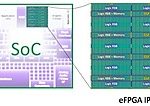Podcast EP33: Processing AI Workloadsby Daniel Nenni on 08-13-2021 at 10:00 amCategories: Uncategorized
Dan and Mike are joined by Dana McCarty, vice president of sales and marketing at Flex Logix Technologies, Inc. Using an eFPGA-based architecture for processing AI workloads is discussed, along with typical applications and power, performance and cost benefits. The competitive positioning of Flex Logix’s InferX X1 … Read More
In early April, Gabriele Saucier kicked off Design & Reuse’s IPSoC Silicon Valley 2021 Conference. IPSoC conference as the name suggests is dedicated to semiconductor intellectual property (IP) and IP-based electronic systems. There were a number of excellent presentations at the conference. The presentations had been… Read More
Dan and Mike are joined by Geoff Tate, founding CEO of Flex Logix. Geoff has a storied career in semiconductors that includes over ten years at AMD, ending as senior VP, microprocessors and logic. Following AMD, Geoff was founding CEO of Rambus, growing the company from four people to IPO with a $2 billion market cap.
As co-founder… Read More
Flex Logix is a unique company. It is one of the few that supplies both FPGA and embedded FPGA technology based on a proprietary programmable interconnect that uses half the transistors and half the metal layers of traditional FPGA interconnect. Their architecture provides some rather significant advantages. I wrote about their… Read More
eFPGA is now widely available, has been used in dozens of chips, is being designed into dozens more and it has an increasing list of benefits for a range of applications. Embedded FPGA, or eFPGA, enables your SoC to have flexibility in critical areas where algorithm, protocol or market needs are changing. FPGAs can also accelerate… Read More
We started working with Felx Logix more than eight years ago and let me tell you it has been an interesting journey. Geoff Tate was our second CEO Interview so this is a follow up to that. The first one garnered more than 15,000 views and I expect more this time given the continued success of Flex Logix pioneering the eFPGA market, absolutely.… Read More
Some amazing hardware is being designed to accelerate AI/ML, most of which features large numbers of MAC units. Given that MAC units are like the lego blocks of digital math, they are also useful for a number of other applications. System designers are waking up to the idea of repurposing AI accelerators for DSP functions such as … Read More
Last week I attended the Linley Fall Processor Conference held in Santa Clara, CA. This blog is the first of three blogs I will be writing based on things I saw and heard at the event.
In April, Flex Logix announced its InferX X1 edge inference co-processor. At that time, Flex Logix announced that the IP would be available and that a chip,… Read More
In the old days, product architects would throw a functional block diagram “over the wall” to the design team, who would plan the physical implementation, analyze the timing of estimated critical paths, and forecast the signal switching activity on representative benchmarks. A common reply back to the architects was, “We’ve… Read More
eFPGA stands for embedded Field Programmable Grid Arrays. An eFPGA is a programmable device like an FPGA but rather than being sold as a completed chip it is licensed as a semiconductor IP block. ASIC designers can license this IP and embed it into their own chips adding the flexibility of programmability at an incremental cost.… Read More








